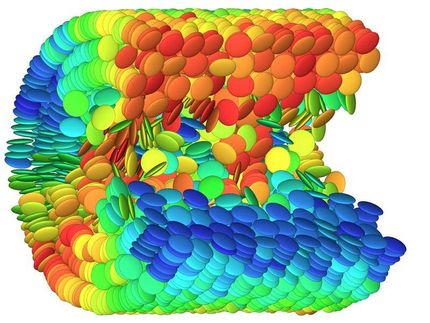Unveiling molecular origami: A breakthrough in dynamic materials
Origami, traditionally associated with paper folding, has transcended its craft origins to influence a diverse range of fields, including art, science, engineering, and architecture. Recently, origami principles have extended to technology, with applications spanning solar cells to biomedical devices. While origami-inspired materials have been explored at various scales, the challenge of creating molecular materials based on origami tessellations has remained. Addressing this challenge, a team of researchers, led by Professor Wonyoung Choe in the Department of Chemistry at Ulsan National Institute of Science and Technology (UNIST), South Korea, has unveiled a remarkable breakthrough in the form of a two-dimensional (2D) Metal Organic Framework (MOF) that showcases unprecedented origami-like movement at the molecular level.

(Top left circle) Eunji Jin, the first author of the study. From top row, left are Junghye Lee, Invited Professor Eunyoung Kang, Joohan Nam, and Hyeonsoo Cho. From bottom row, left are Professor Wonyoung Choe, Professor Seung Kyu Min, and In Seong Lee.
UNIST
Metal-Organic Frameworks (MOFs) have long been recognized for their structural flexibility, making them an ideal platform for origami tessellation-based materials. However, their application in this context is still in its early stages. Through the development of a 2D MOF based on the origami tessellation, the research team has achieved a significant milestone. The researchers utilized temperature-dependent synchrotron single-crystal X-ray diffraction to demonstrate the origami-like folding behavior of the 2D MOF in response to temperature changes. This behavior showcases negative thermal expansion and reveals a unique origami tessellation pattern, previously unseen at the molecular level.
The key to this breakthrough lies in the choice of MOFs, which incorporate flexible structural building blocks. The inherent flexibility enables the origami-like movement, observed in the 2D MOF. The study highlights the deformable net topology of the materials. Additionally, the role of solvents in maintaining the packing between 2D framework in MOFs is emphasized, as it directly affects the degree of folding.
“This groundbreaking research opens new avenues for origami-inspired materials at the molecular level, introducing the concept of origamic MOFs. The findings not only contribute to the understanding of dynamic behavior in MOFs, but also offer potential applications in mechanical metamaterials.” noted Professor Wonyoung Choe. He further highlighted the potential of molecular level control over origami movement, as a platform for designing advanced materials with unique mechanical properties. The study also suggests exciting possibilities for tailoring origamic MOFs for specific applications, including advancements in molecular quantum computing.
Original publication
Eunji Jin, In Seong Lee, D. ChangMo Yang, Dohyung Moon, Joohan Nam, Hyeonsoo Cho, Eunyoung Kang, Junghye Lee, Hyuk-Jun Noh, Seung Kyu Min, and Wonyoung Choe, “Origamic Metal-Organic Framework toward Mechanical Metamaterial,” Nature Communctions, (2023).
Most read news
Original publication
Eunji Jin, In Seong Lee, D. ChangMo Yang, Dohyung Moon, Joohan Nam, Hyeonsoo Cho, Eunyoung Kang, Junghye Lee, Hyuk-Jun Noh, Seung Kyu Min, and Wonyoung Choe, “Origamic Metal-Organic Framework toward Mechanical Metamaterial,” Nature Communctions, (2023).
Organizations
Other news from the department science

Get the chemical industry in your inbox
By submitting this form you agree that LUMITOS AG will send you the newsletter(s) selected above by email. Your data will not be passed on to third parties. Your data will be stored and processed in accordance with our data protection regulations. LUMITOS may contact you by email for the purpose of advertising or market and opinion surveys. You can revoke your consent at any time without giving reasons to LUMITOS AG, Ernst-Augustin-Str. 2, 12489 Berlin, Germany or by e-mail at revoke@lumitos.com with effect for the future. In addition, each email contains a link to unsubscribe from the corresponding newsletter.





























































